The National Oceanic and Atmospheric Administration (NOAA) calls it the “greatest snowstorm Colorado has ever seen.” From December 1, through December 5, 1913, the snow poured down. Denver, Colorado was buried in 45.7 inches of snow and Fort Collins recieved 34.5 inches of the white stuff. Our town came to a standstill and it took weeks for some sort of normalcy to return.
Below are five real photo postcards showing what downtown Fort Collins looked like after the storm. I’ve alternated the images with the messages on the postcards and some stories from the Fort Collins Weekly Courier (FCWC), published between December 5 and December 19, 1913. I hope you enjoy this look back at one of the major climate events in Fort Collins History.
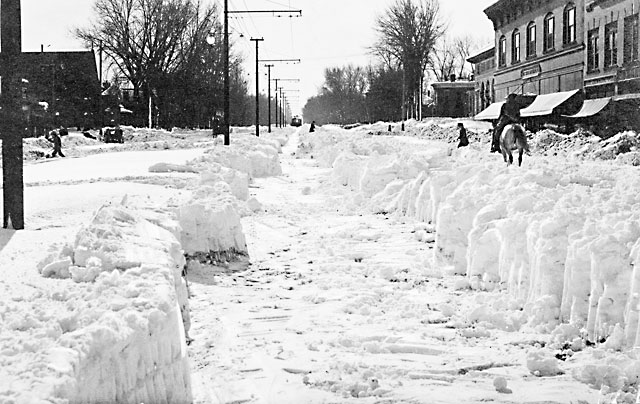
Description: The photographer is standing in the middle of South College Avenue, on the snow packed trolley tracks, looking south towards Oak Street. There is a horse on the right and a trolley car off in the distance. The Post Office is barely visible on the right side of the image.
Postcard Message: “Did you ever see snow to compare . . . with this.? For six weeks this winter the street cars were snowed in. The cattle and sheep men’s loss was terrible. But the snow in winter is where our water comes from for summer.”
FCWC December 5, 1913: “Those who have been wishing and praying for snow have received an answer. The snow is here and a good sized consignment at that. This is the heaviest December snowfall in 15 years.
“The snow put a stop to street car operations here on Monday night [December 1, 1913]. At 8 o’clock the cars could make no progress and were compelled to remain idle.”
FCWC December 5, 1913: “The benefits to the farmer have an immense value to them. . . . The snow will furnish plenty of moisture for this crop and the dry-land farmer generally cannot help but reap a benefit.
“While farmers are rejoicing over the deep snow, there are some who are not happy. Those who are feeding sheep and cattle have troubles ahead of them. Much work is necessary to clean up the snow. In some laces there are large drifts and a careful watch is being kept to see that animals are not buried.”
FCWC December 12, 1913: “A peculiar situation is reported from the Greenacre ranch on the Boxelder northwest of the city. Mike Wessel went out a few days ago looking for live stock and sheep in particular. He was trying to walk over a large drift when he broke through. As he pulled himself out of the hole a lamb jumped out and ran away. Another one followed. He took the two lambs to the feed lot and they went after the feed as though they needed it. The animals had weathered the storm under the drift and were apparently no worse for the experience.”
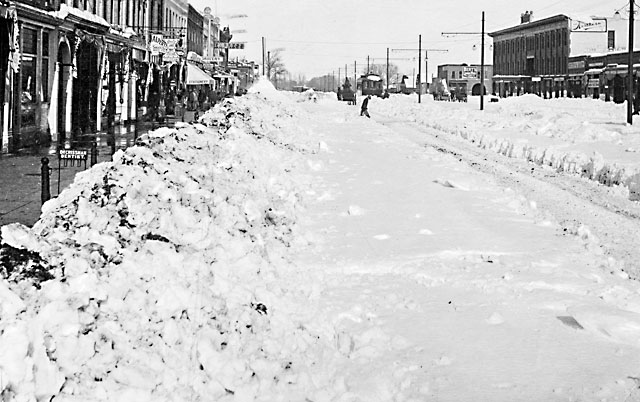
Description: The photographer is standing on the west side of North College Avenue, near Mountain Avenue, shooting north towards the Northern Hotel, shown on the right side.
Postcard Message: [Student writing to his mother in Denver, dated January 5, 1914.] “Got here all right last night. . . . Will send some film soon to have you print. Got some swell pictures.”
Below is a close-up of the trolley and people towards the back of the image.
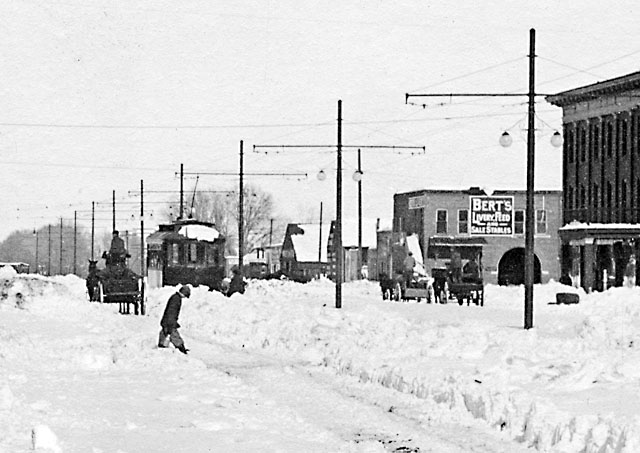
Description: Bert’s Livery & Feed is on the north corner of Walnut. A few years earlier, Bert’s was across College on the north side of Laporte Avenue. (See the post, Laporte Avenue: Horses, Trains, and Automobiles.) In less than five years, both the new and the old Bert Livery locations would be automobile garages, places to store and have your automobile repaired.
I believe there are two men working in front of the trolley car. Getting the trolley tracks clear and the system up and running was a big issue.
FCWC December 12, 1913: “The street railway cars are about at a standstill and doing the public no more good than they did on Friday [December 5] when the snow was three feet deep. The efforts to move the cars has not been very strenuous. . . . Some snow plow work has been done. . . . Men are putting in a few licks with pick and shovel . . . but the impression is not noticeable.”

Description: An image much like Image 2 but taken from the sidewalk.
Postcard Message: [Written January 1, 1914] “This picture is on North College in front of Jones Dry Goods. You can see how we have to hitch to, yet lots of places you can’t get.”
You can see that the hitching posts are clear on the sidewalk side but the piles of snow obviously made it hard or impossible to tie up your horse. All hitching posts were removed when College Avenue was paved in 1916.
In this image, the sidewalk is pretty clear but that wasn’t true all over town.
FCWC December 12, 1913: “City Issues Mandate About Snow. It must be moved from walks, alleys, and streets. Complaints are to be filed against those who have piled up snow or refuse to clean up sidewalks. . . . The city has done more than its share in clearing up the snow blockade but there are some people who have an idea that they are privileged characters and do not have to make a passage for the public. . . . Some men are having the snow hauled away. Others will have to do the same.”
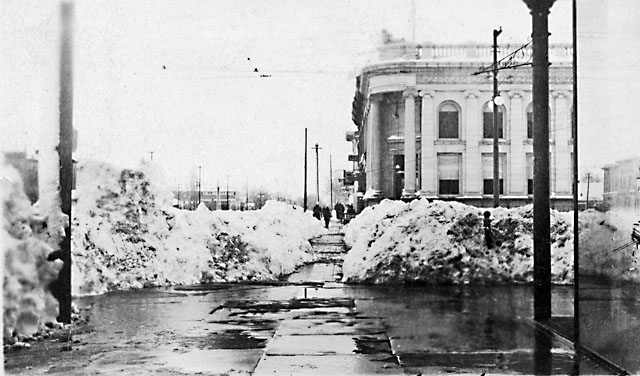
Description: This is the southwest corner of College and Mountain, looking east towards the First National Bank.
Postcard Message: “Now you can see how this burg looks on Jan, 11, 1914.” The writer was apparently stuck in town but told his mother, “I may well [leave] tomorrow.”
The snow slowed or stopped normal transportation as covered in the two newspaper clippings below.
FCWC December 12, 1913: “Coal dealers of the city are doing their best to supply those absolutely in need of fuel. Delivering coal is more than a boy’s task. It belongs to full grown men with plenty of horses to assist. On Friday several attempts were made to deliver small quantities of coal, but horses were stalled and many places were buried so that they had to be shoveled out.
“Today with more teams using the streets [and] packing the snow down, horses and vehicles are able to get to some of those in need . . . but it is an expensive piece of work and hard on men and horses. The cost of delivery is almost as much as the price of coal but dealers are standing the cost.”
FCWC December 19, 1913: “For the first time in nearly two weeks train service has resumed between Cheyenne and the city. The regular morning passenger train arrived here today on time. The rotary snow plow cleared the track Monday . . . and did the job so thoroughly that little difficulty was experienced by the passenger train in getting through.”
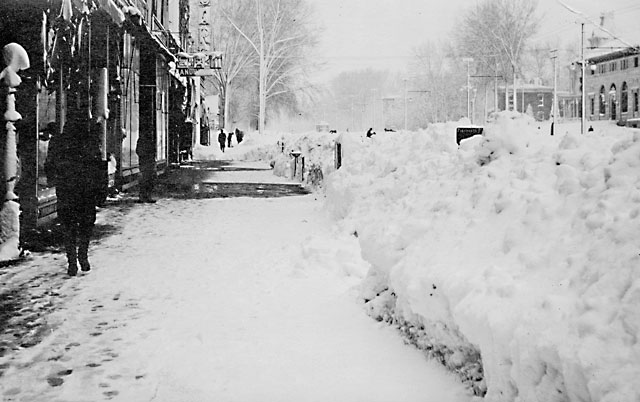
Description: Snow is piled up, burying the hitching post and curb side signs in this card postmarked December 27, 1913. The photographer is on the east side of South College Avenue, shooting south. You can see the post office on the right side of the image.
Postcard Message: “Fort Collins after the snow. At Rustic [along the Poudre Canyon] 52 inches. It fell the week following Thanksgiving and only the main roads broken out yet. Elegant sleighing.”
It would take awhile before the local newspaper cared enough about the county roads to report on them but they finally did, as you can see from these clippings from the December 19, 1913, FCWC. The article was entitled “County Plowing Snow Off the Roads.”
“In order to permit vehicles to use the roads all manner of schemes are being tried by the county. . . . In places horses are being used to break a trail so that other animals can be used to pull ‘V’ shaped plows to shove snow to either side of the road. . . The task seems almost a hopeless one.”
“At Owl Canon the snow was so deep that it was necessary to shovel a road through, horses being unable to break a road.”
“The road at Harmony which runs east and west is covered with badly drifted snow. . .At present it is impossible for a wagon to travel over the road.”
“Norman Frey is working out from Rustic in snow from four to seven feet deep and progress is very slow.”
“W. S. Warner sent word today that he had cut a road up the Big Thompson to Drake. His men and horses are played out and help asked for. In places the snow is 15 feet deep.”
Of course the children found the snow wonderful. Schools were closed for awhile but even when they opened, the children found much to like as covered in this article.
FCWC December 19, 1913: “The wagons on the Consolidated district service are operating on bobsleds instead of wheels now. [Bobsled – A wooden wagon body, with bench seats down both sides, mounted on two sets of sturdy runners and pulled by horses.] With the bobs the rigs are able to make better time and furnish the children with rare sport.”
On Thursday, I’ll post another image that doesn’t require many words to enjoy. I hope you like it.